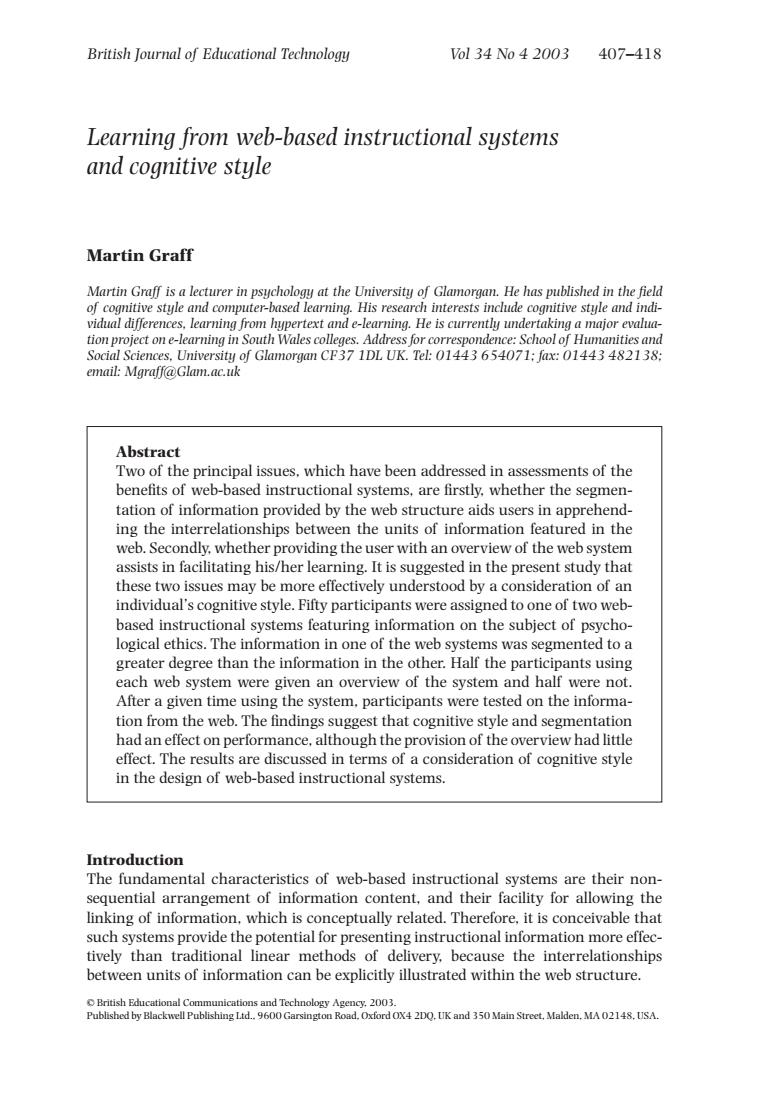正在加载图片...

British Journal of Educational Technology ol34N642003 407-418 Learning from web-based instructional systems and cognitive style Martin Graff H ertextnde-le ning.He is currently undertaking a major evalua Cp37DL7t01446540710144348213 email:Mgraff@Glam.ac.uk Abstract n of the prinnructional systems.areiraessments oen sed in of inom aids use th units 01 y.w w of the web mybe morc et照Sh participants based instructional systems featuring information on the subject of psycho logical ethics.The information in one of the web systems was segmented to a greater degree than the information in the other.Half the participants using each web system were given an overview of the system and ha were nol After a given time using the system.participants were tested on the informa tion from the web.The findings suggest that cognitive style and segmentatior had an effect on performance.although the provision of the overview had little effect.The results are discussed in terms of a consideration of cognitive style in the design of web-based instructional systems. Int roductior The fur mental characteristics of web-based instruc rrang king of informa ystems provide th e potentia tion more el tively than ona linear me of very.t rrelatio hips between units of information can be explicitly illustrated within the web structure. Abstract Two of the principal issues, which have been addressed in assessments of the benefits of web-based instructional systems, are firstly, whether the segmentation of information provided by the web structure aids users in apprehending the interrelationships between the units of information featured in the web. Secondly, whether providing the user with an overview of the web system assists in facilitating his/her learning. It is suggested in the present study that these two issues may be more effectively understood by a consideration of an individual’s cognitive style. Fifty participants were assigned to one of two webbased instructional systems featuring information on the subject of psychological ethics. The information in one of the web systems was segmented to a greater degree than the information in the other. Half the participants using each web system were given an overview of the system and half were not. After a given time using the system, participants were tested on the information from the web. The findings suggest that cognitive style and segmentation had an effect on performance, although the provision of the overview had little effect. The results are discussed in terms of a consideration of cognitive style in the design of web-based instructional systems. Learning from web-based instructional systems and cognitive style Martin Graff Martin Graff is a lecturer in psychology at the University of Glamorgan. He has published in the field of cognitive style and computer-based learning. His research interests include cognitive style and individual differences, learning from hypertext and e-learning. He is currently undertaking a major evaluation project on e-learning in South Wales colleges. Address for correspondence: School of Humanities and Social Sciences, University of Glamorgan CF37 1DL UK. Tel: 01443 654071; fax: 01443 482138; email: Mgraff@Glam.ac.uk © British Educational Communications and Technology Agency, 2003. Published by Blackwell Publishing Ltd., 9600 Garsington Road, Oxford OX4 2DQ, UK and 350 Main Street, Malden, MA 02148, USA. Introduction The fundamental characteristics of web-based instructional systems are their nonsequential arrangement of information content, and their facility for allowing the linking of information, which is conceptually related. Therefore, it is conceivable that such systems provide the potential for presenting instructional information more effectively than traditional linear methods of delivery, because the interrelationships between units of information can be explicitly illustrated within the web structure. British Journal of Educational Technology Vol 34 No 4 2003 407–418